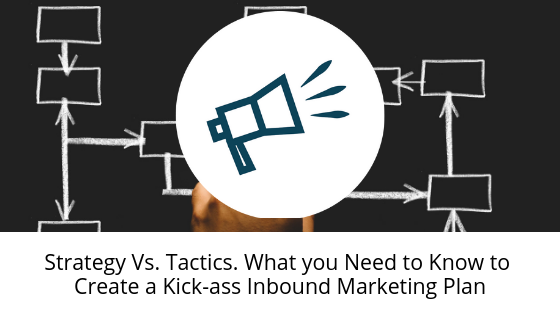Alicia: Hello everyone, and thank you for joining us for our discussion on inbound marketing strategies and tactics. My name is Alicia Blackburn from WeSpeak Easy, and I am here with Jess Sherry. We are here today to sit down and discuss strategy and tactics in inbound marketing. We are going to cover what they are, how they are different, and how they work together to get your business the results that you are looking for.
So Jess, what do you think the number one thing is that holds people back from success with digital marketing?
Jess: You’re not starting off easy, are you? We’ve worked with a lot of companies on their inbound marketing, and the customers who get the results they want are the ones who understand the difference and interplay between tactics and strategies.
Alicia: That is interesting, can you explain what you mean by that?
Jess: So a strategy outlines your overarching, long-term goal and how you are going to get there. For instance, we are going to get 100 more customers and increase ROI 25 percent by getting more people to sign up for our email list, or we are going to get broader brand recognition by increasing our follower base and engagement. For a non-business world example, let’s say that our strategy is to shave five minutes off of our 5k runs through diet and exercise.
Alicia: So with those examples you’ve outlined where you want to go, but there isn’t a lot of detail. Doesn’t strategy involve all the little steps about how to get there?
Jess: That is actually a very common misconception. Those little steps aren’t part of the strategy. A strategy is setting up the foundation and establishing a goal before you get bogged down in the details.
Alicia: That makes sense, but it doesn’t seem like you could run a campaign with just that.
Jess: Well, that’s because you can’t. Strategy is just where you start. The strategy is deciding where you want to go. You need tactics to get you across the finish line.
Alicia: Can you explain a little more about what tactics are?
Jess: Sure. Tactics are the building blocks to the strategy’s blueprint. Let’s go back to our running example. You know you are going to use diet and exercise to shave five minutes off your 5k time. Great! So now you need to know the tactics. What is your diet going to be and what exercises are you going to do?
Alicia: Now see, to me that sounds like a strategy, and what you described as a strategy sounds like goals.
Jess: I understand why you would think that. It’s really a product of our language and how fluid it is. For many people, it’s not a strategy without tactics. In reality, you need to the strategy to find the right tactics.
Alicia: So you need both to have a successful campaign?
Jess: Yes. Well, really you need three things. A goal, a strategy, and tactics. Those three things build on each other to form a solid campaign.
Alicia: You said at the beginning that not understanding the difference is the biggest thing that holds companies back from succeeding at inbound marketing. Why is that?
Jess: When you don’t understand the difference between strategy and tactics, or even what a strategy really looks like, it is easy to push forward with only tactics. These companies have a vague notion of “we want to make more money,” which is a very generic goal, and they know blogging is a great way to get people to their site, so they just pour time into that. In the end, they don’t get much more traffic, maybe a handful of new customers, and they come back to us and want to know why it’s not working. There is no strategy there, but they think there is because they have a goal and some tactics. The strategy is really what ties those two together and makes sure the tactics stay on track for fulfilling a goal.
Alicia: Can you walk us through what a good goal, strategy, and set of tactics looks like?
Jess: Sure. So I am going to “run” with the 5k scenario (pun intended) for the simplicity. The goal here is to cut five minutes off your overall 5k time in the next three months. This is a good goal because it is quantifiable, and there is a time limit. You can clearly measure your success. The strategy here is to utilize diet to lose fat, to provide protein for muscle growth, and well-timed carbs for energy before a run. Then we can use exercise to build up the muscles and train them to work more efficiently. Now that we have a strategy in place, we can research what tactics will work best with that strategy. So now, we can decide on a low carb, high protein diet with most of the remaining carbs being consumed before a run, yoga to help with stretching and muscle grown, a half hour of running 5 days a week, a longer run on Saturday, and weighted squats, leg lifts, and stair runs to build the muscle further.
Alicia: So all together they make a comprehensive plan.
Jess: That is the general idea, yes.
Alicia: This has all been very informative. Is there anything else about strategies and tactics people need to keep in mind?
Jess: I am glad you asked that. Something a lot of people don’t think about is there are different levels of strategies, and there are different tactics that can be used for the same strategy. For instance, back to running. That could be one of the strategies that feed into an overall strategy of being healthier. Maybe the other sub-strategy is to stop smoking by Christmas or to meditate five minutes a day.
Additionally, sometimes tactics don’t work the way we expect. What if you actually start slowing down from muscle fatigue? Maybe you need to only run four days a week instead of six. So because you have those measurable goals and the time limit, you can see that you are not on-track and change your tactics to better drive your strategy. Does that make sense?
Alicia: Yes! So do you have any final thoughts on strategy and tactics as it pertains to inbound marketing?
Jess: Don’t get too married to the tactics. Often we hear “Well our competitors are using. . . ‘insert favorite tactic here’ so it must work for our vertical.” Most of the time, that’s a false assumption. You don’t know what their goals and strategies are, and you don’t even know if it’s actually working for them or if they are just stubbornly holding on it! We’ve had so many clients in the past whom insist we execute a tactic their way, and then it fails. We try the tactics we landed on using our strategy to get them to their goals, and they work, and often times our clients are blown away. Inbound marketing is powerful, but only when you have that solid well thought out strategy in place. Tactics alone, and you might as well be preaching to the choir.
Alicia: And we all know how useful that is. Thank you so much Jess for joining us today. This is Alicia for WeSpeak Easy. We hope you learned a lot about strategies and tactics. If you have any questions or want to learn more, please feel free to reach out to us through our website at www.wespeakeasy.com or on Facebook, Instagram, or twitter @wespeaksocial. We look forward to hearing from you and hope you have a great day!


Recent Comments